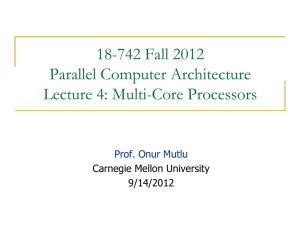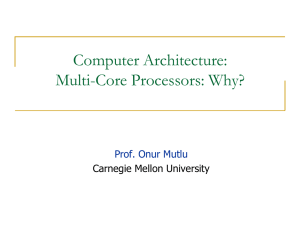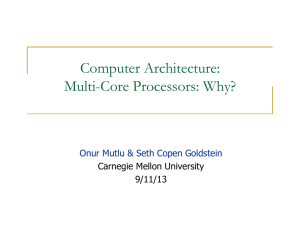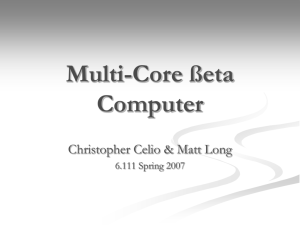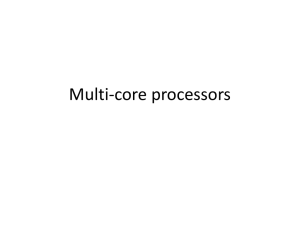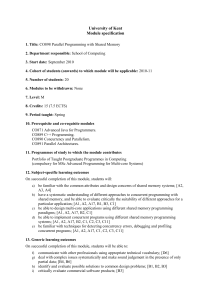18-742 Spring 2011 Parallel Computer Architecture Lecture 4: Multi-core Prof. Onur Mutlu
advertisement
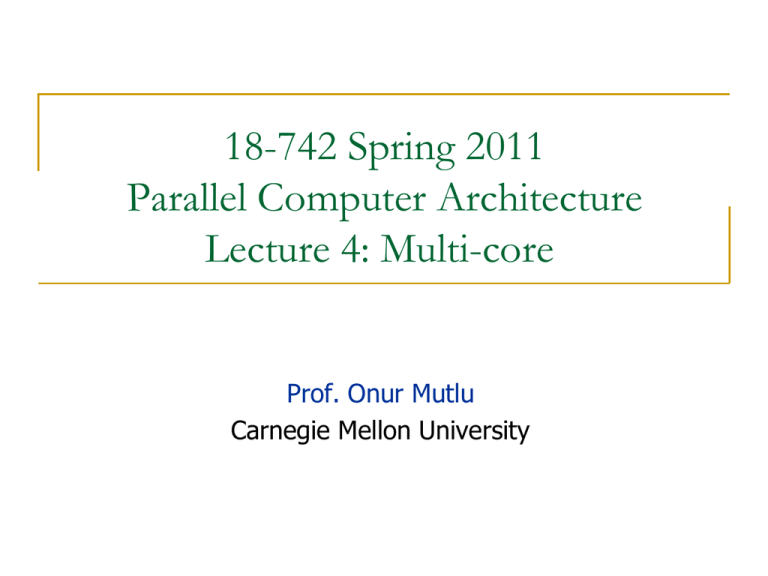
18-742 Spring 2011 Parallel Computer Architecture Lecture 4: Multi-core Prof. Onur Mutlu Carnegie Mellon University Research Project Project proposal due: Jan 31 Project topics Does everyone have a topic? Does everyone have a partner? Does anyone have too many partners? 2 Last Lecture Programming model vs. architecture Message Passing vs. Shared Memory Data Parallel Dataflow Generic Parallel Machine 3 Readings for Today Required: Hill and Marty, “Amdahl’s Law in the Multi-Core Era,” IEEE Computer 2008. Annavaram et al., “Mitigating Amdahl’s Law Through EPI Throttling,” ISCA 2005. Suleman et al., “Accelerating Critical Section Execution with Asymmetric Multi-Core Architectures,” ASPLOS 2009. Ipek et al., “Core Fusion: Accommodating Software Diversity in Chip Multiprocessors,” ISCA 2007. Recommended: Olukotun et al., “The Case for a Single-Chip Multiprocessor,” ASPLOS 1996. Barroso et al., “Piranha: A Scalable Architecture Based on Single-Chip Multiprocessing,” ISCA 2000. Kongetira et al., “Niagara: A 32-Way Multithreaded SPARC Processor,” IEEE Micro 2005. Amdahl, “Validity of the single processor approach to achieving large scale computing capabilities,” AFIPS 1967. 4 Reviews Due Today (Jan 21) Due Next Tuesday (Jan 25) Seitz, The Cosmic Cube, CACM 1985. Suleman et al., Accelerating Critical Section Execution with Asymmetric Multi-Core Architectures, ASPLOS 2009. Papamarcos and Patel, A low-overhead coherence solution for multiprocessors with private cache memories, ISCA 1984. Kelm et al., Cohesion: a hybrid memory model for accelerators, ISCA 2010. Due Next Friday (Jan 28) Suleman et al., Data Marshaling for Multi-Core Architectures, ISCA 2010. 5 Recap of Last Lecture 6 Review: Shared Memory vs. Message Passing Loosely coupled multiprocessors No shared global memory address space Multicomputer network Usually programmed via message passing Network-based multiprocessors Explicit calls (send, receive) for communication Tightly coupled multiprocessors Shared global memory address space Traditional multiprocessing: symmetric multiprocessing (SMP) Existing multi-core processors, multithreaded processors Programming model similar to uniprocessors except (multitasking uniprocessor) Operations on shared data require synchronization 7 Programming Models vs. Architectures Five major models Shared memory Message passing Data parallel (SIMD) Dataflow Systolic Hybrid models? 8 Scalability, Convergence, and Some Terminology 9 Scaling Shared Memory Architectures 10 Interconnection Schemes for Shared Memory Scalability dependent on interconnect 11 UMA/UCA: Uniform Memory or Cache Access Uniform Memory/Cache Access Example SMP Quad-pack Intel Pentium Pro 14 How to Scale Shared Memory Machines? Two general approaches Maintain UMA Provide a scalable interconnect to memory Downside: Every memory access incurs the round-trip network latency Interconnect complete processors with local memory NUMA (Non-uniform memory access) Local memory faster than remote memory Still needs a scalable interconnect for accessing remote memory Not on the critical path of local memory access 15 NUMA/NUCA: NonUniform Memory/Cache Access Example NUMA MAchines Sun Enterprise Server Cray T3E 17 Convergence of Parallel Architectures Scalable shared memory architecture is similar to scalable message passing architecture Main difference: is remote memory accessible with loads/stores? 18 Historical Evolution: 1960s & 70s Historical Evolution: 1980s Historical Evolution: Late 80s, mid 90s Historical Evolution: Current Chip multiprocessors (multi-core) Small to Mid-Scale multi-socket CMPs Clusters/Datacenters Use high performance LAN to connect SMP blades, racks Driven by economics and cost One module type: processor + caches + memory Smaller systems => higher volumes Off-the-shelf components Driven by applications Many more throughput applications (web servers) … than parallel applications (weather prediction) Cloud computing Historical Evolution: Future Cluster/datacenter on a chip? Heterogeneous multi-core? Bounce back to small-scale multi-core? ??? 23 Multi-Core Processors 24 Moore s Law Moore, Cramming more components onto integrated circuits, Electronics, 1965. 25 Multi-Core Idea: Put multiple processors on the same die. Technology scaling (Moore s Law) enables more transistors to be placed on the same die area What else could you do with the die area you dedicate to multiple processors? Have a bigger, more powerful core Have larger caches in the memory hierarchy Simultaneous multithreading Integrate platform components on chip (e.g., network interface, memory controllers) 26 Why Multi-Core? Alternative: Bigger, more powerful single core Larger superscalar issue width, larger instruction window, more execution units, large trace caches, large branch predictors, etc + Improves single-thread performance transparently to programmer, compiler - Very difficult to design (Scalable algorithms for improving single-thread performance elusive) - Power hungry – many out-of-order execution structures consume significant power/area when scaled. Why? - Diminishing returns on performance - Does not significantly help memory-bound application performance (Scalable algorithms for this elusive) 27 Large Superscalar vs. Multi-Core Olukotun et al., The Case for a Single-Chip Multiprocessor, ASPLOS 1996. 28 Multi-Core vs. Large Superscalar Multi-core advantages + Simpler cores more power efficient, lower complexity, easier to design and replicate, higher frequency (shorter wires, smaller structures) + Higher system throughput on multiprogrammed workloads reduced context switches + Higher system throughput in parallel applications Multi-core disadvantages - Requires parallel tasks/threads to improve performance (parallel programming) - Resource sharing can reduce single-thread performance - Shared hardware resources need to be managed - Number of pins limits data supply for increased demand 29 Large Superscalar vs. Multi-Core Olukotun et al., The Case for a Single-Chip Multiprocessor, ASPLOS 1996. Technology push Instruction issue queue size limits the cycle time of the superscalar, OoO processor diminishing performance Quadratic increase in complexity with issue width Large, multi-ported register files to support large instruction windows and issue widths reduced frequency or longer RF access, diminishing performance Application pull Integer applications: little parallelism? FP applications: abundant loop-level parallelism Others (transaction proc., multiprogramming): CMP better fit 30 Why Multi-Core? Alternative: Bigger caches + Improves single-thread performance transparently to programmer, compiler + Simple to design - Diminishing single-thread performance returns from cache size. Why? - Multiple levels complicate memory hierarchy 31 Cache vs. Core Number of Transistors Cache Microprocessor Time 32 Why Multi-Core? Alternative: (Simultaneous) Multithreading + + + + Exploits thread-level parallelism (just like multi-core) Good single-thread performance when there is a single thread No need to have an entire core for another thread Parallel performance aided by tight sharing of caches - Scalability is limited: need bigger register files, larger issue width (and associated costs) to have many threads complex with many threads - Parallel performance limited by shared fetch bandwidth - Extensive resource sharing at the pipeline and memory system reduces both single-thread and parallel application performance 33
